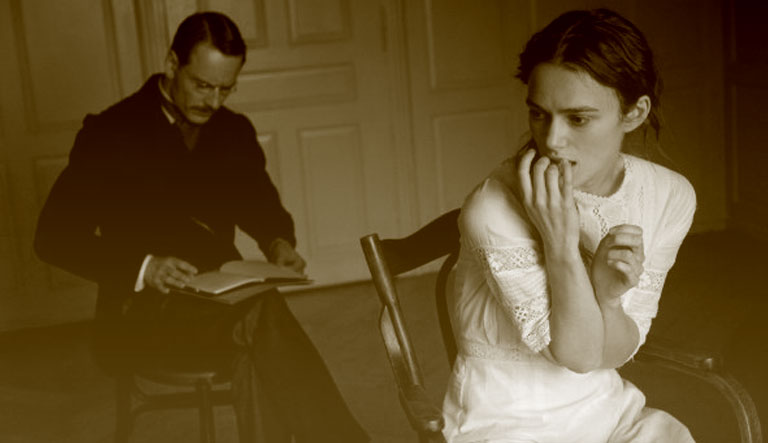
|

|

|

|

|

|

|

|

|

|

|

|

A Dangerous method began as a screenplay in the mid-1990s. Screenwriter Christopher Hampton has a keen interest in psychoanalysis, and spent a great deal of time researching the relationships between Jung, Freud and Sabina, visiting the Burgholzli hospital in Zurch where he read her case story. These intelligent figures greatly appealed to Hampton, as he explains, “These people were pioneers and psychoanalysis was a revolutionary idea. It opened many closets and revealed many taboos. At the end of the nineteenth century, great currents of new ideas were brought into being which opened up a whole new way of thinking about society.”
Hampton went on to develop the material into a stage play called The Talking Cure, which had a successful run at the National Theatre in London with Ralph Fiennes starring as Jung. A few years later, acclaimed auteur David Cronenberg asked Hampton to adapt the play into a new screenplay for him to direct. As Cronenberg elaborates, “In Christopher Hampton’s original play I knew I had found a rich vein to mine for the screen. This tale of emotional variance, overshadowed by the portents of WWI, promised an insight into two intense and inextricably interwoven relationships. The fact that the characters were gifted true-life figures, and that the triangle of Jung, Freud and Sabina resulted in the birth of modern psychoanalysis, made it all the more tantalising to me.”
Hampton began to develop his play, weaving historical events and quotes from the real-life personalities into a dramatic story of a debate of ideas. Cronenberg took the project to his good friend Jeremy Thomas, who has a reputation for working with highly individual filmmakers and has previously teamed with Cronenberg to make the critically acclaimed films Crash and Naked Lunch. For Thomas, the appeal was immediate. As he explains, “The exciting pairing of director David Cronenberg with the great playwright and screenwriter Christopher Hampton would be too rare an event for me to miss. The opportunity to work with David again on a project of such note seemed a natural fit with this very interesting clash of ideas on screen. There is an enormous amount of duelling in the dialogue which I thought could be very attractive to watch when played by very good actors, and have an impact on an audience when directed by a wonderful director with a magnificent score.”

For Hampton the opportunity to work with Cronenberg, a filmmaker he admired, was one he approached with relish: “I think David has a unique combination of extremely cool objectivity, and pretty violent engagement. A really original combination which fits this story very well, because it’s a story about people who are attempting to operate the rules of civilization and steer their patients towards ‘the norm’, whilst becoming increasingly aware that there is no norm and that they themselves, like all of us in certain respects, live right out on the wild fringes and have to cope with these contradictions as best we can. David is a wonderful director to encompass these contradictions and make sense of them.”
For his part, Cronenberg was captivated by the idea of directing a film about three charismatic figures from history, including Sabina; a relatively unknown figure who greatly influenced both men professionally. As he says, “Sabina was someone who contributed hugely to the theories of both men, something that no one knew until a cache of letters was discovered, her letters to and from Freud and Jing, and their letters to her. Their passion came through their articulation, their theories and their abstract thoughts. They were really quite fascinating people and it’s a fantastic story.”

For Thomas, a producer widely recognized for his distinctive films, this little known story was one he knew he had to bring to the screen, “I have always been drawn to make unusual stories that often involve extreme behavior. At the heart of “A Dangerous Method” is a fascinating story that highlights how even those who understand humanity best can fall prey to mankind’s most basic emotions. Love, sexual passion, ambition, deceit, emotional breakdowns, explosive disagreements and apocalyptic dreams set the foundation for the pivotal moment when Jung, Freud and Sabina came together and then split, forever changing the face of modern thought. These intimate dynamics twinned with the broader span of history is what makes this film irresistible for me.”
